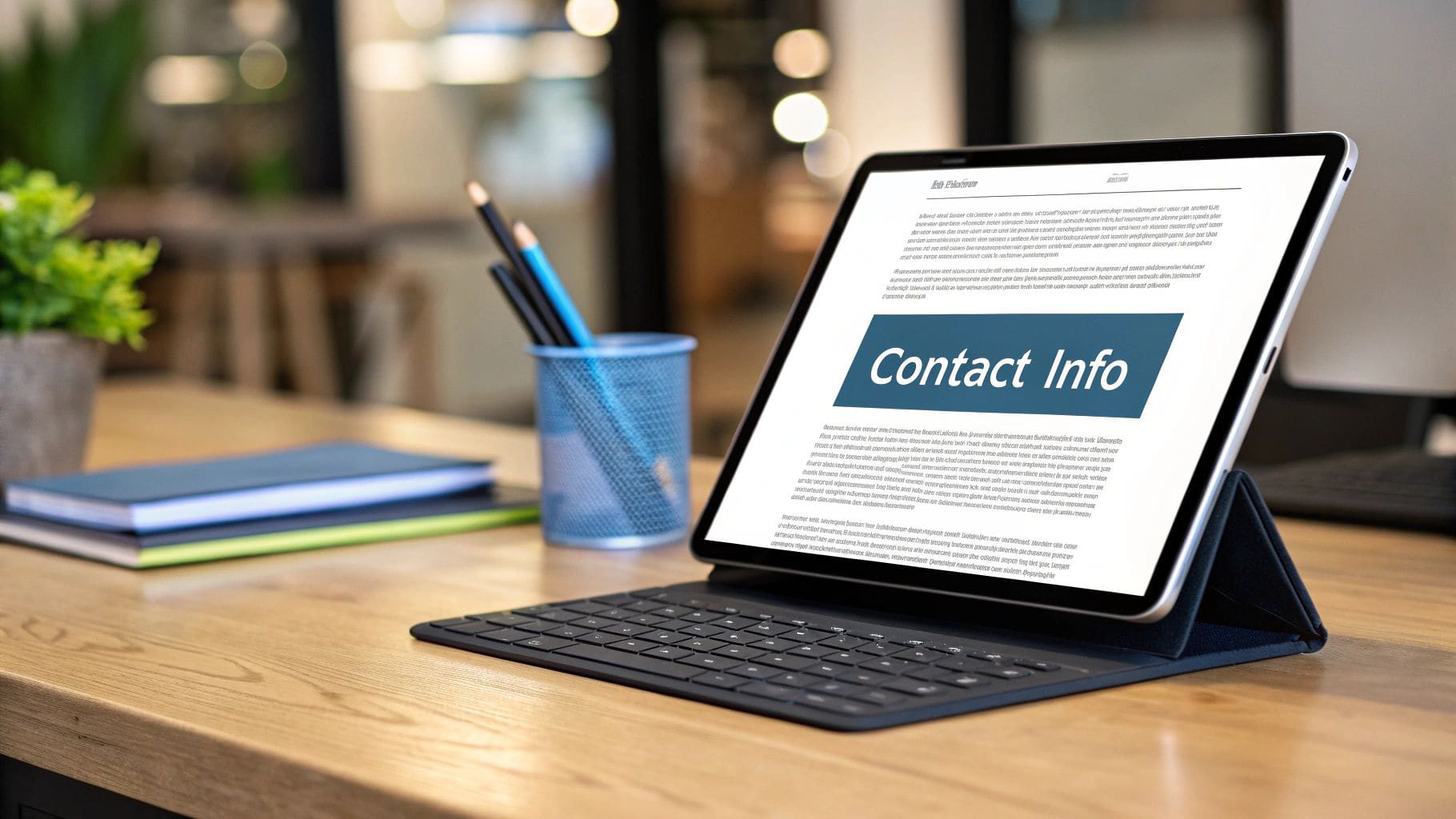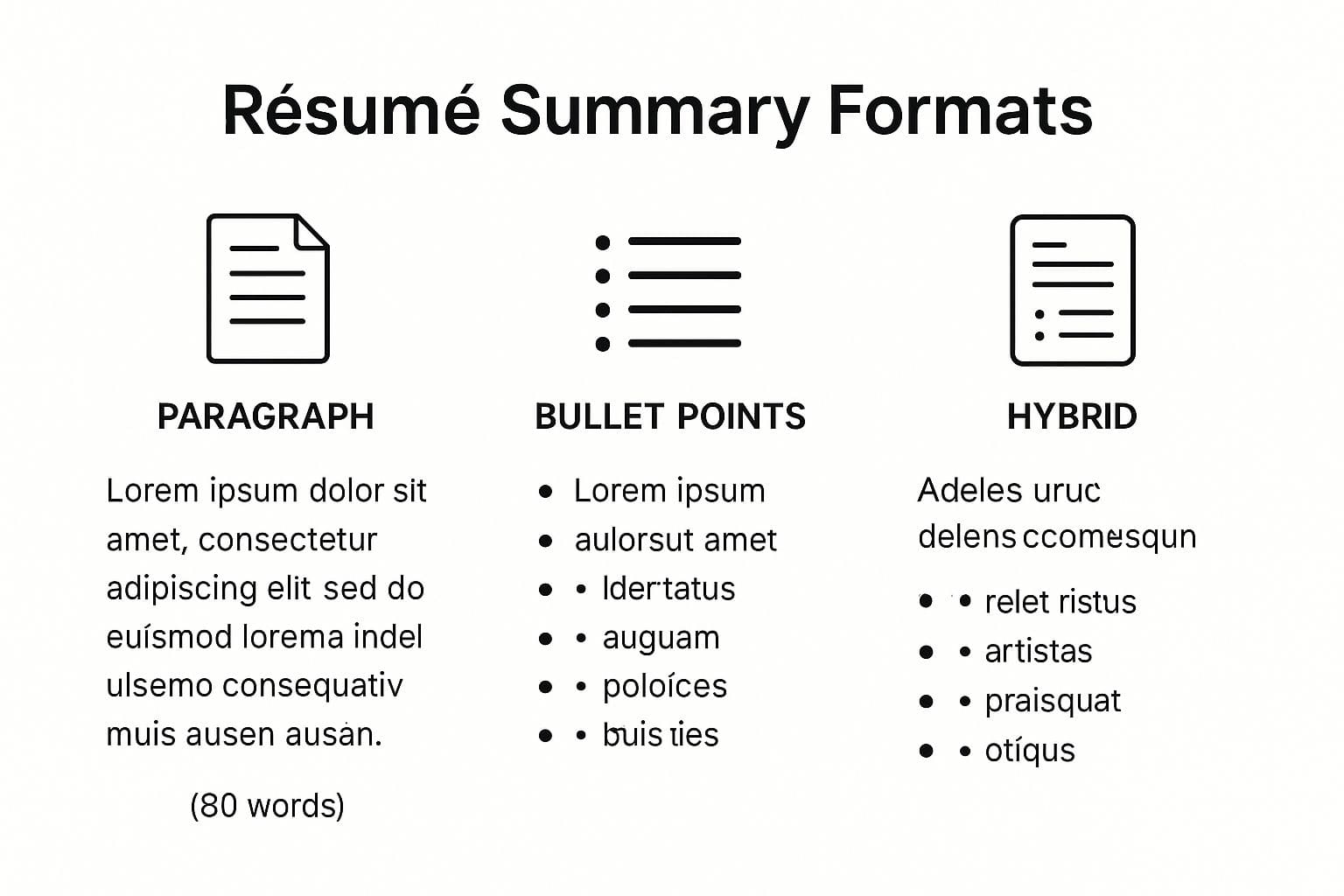Understanding the Format of Modern Resume for Success
Understanding the Format of Modern Resume for Success
A modern resume format is a strategic tool, carefully designed to get past automated screening systems while speaking persuasively to a human recruiter. The goal is to prioritize clarity, keyword optimization, and real, measurable achievements over the clunky, text-heavy designs of the past.
This means using clean fonts, scannable sections, and a structure that puts your most relevant skills and experience front and center. For example, instead of a dense paragraph, you'll use bullet points that start with action verbs and end with quantifiable results.
Why Your Resume Format Needs a Modern Overhaul

If you're still using a resume format from five years ago, you might as well be invisible to potential employers. The hiring process has been completely reshaped by technology. Your resume is no longer just for human eyes; it's a key that first has to unlock a digital door.
That door is guarded by Applicant Tracking Systems (ATS), the sophisticated software used by over 98% of Fortune 500 companies and a huge number of smaller businesses, too. An ATS scans resumes for specific keywords and formatting cues to filter out candidates before a hiring manager ever sees a single application.
The Rise of the Digital Gatekeeper
Think of an ATS as an automated bouncer. If your resume shows up with complex tables, images in the header, or custom section titles like "My Professional Journey," the software can't read it. That confusion often gets your application tossed in the digital trash bin, no matter how perfect you are for the job.
A truly modern resume format is engineered to be clean, structured, and easily understood by these systems. Your actionable outcome is to use standard headings like "Work Experience" and "Skills" and avoid text boxes or graphics that can confuse the software.
The game has changed. Driven by AI-powered tools and the explosion of remote work, competition is fiercer than ever. In this new world, old-school approaches are a liability. By 2025, the job market has settled on five dominant resume formats—Enhanced Chronological, Strategic Hybrid, ATS-Optimized, Visual-Strategic, and Skills-Based Hybrid—each one built to navigate these automated screenings. Sticking with a traditional format like a Pure Functional resume or a generic template is a recipe for instant disqualification.
Beyond the Bots to the Recruiter
Of course, getting past the ATS is only the first hurdle. Once your resume lands in front of a real person, you have just a few seconds to make your case. A modern format uses smart design—like bolding key metrics or using white space—to guide the recruiter's eye straight to your most impressive qualifications.
This is why a modern overhaul isn't just a nice-to-have; it's absolutely essential. It ensures your resume works in today's hiring landscape, satisfying both the robots and the recruiters.
Adopting a proper format of modern resume is the single most important step you can take to get seen and hired. If you're ready to get started, you might want to explore our detailed guide on the modern resume format.
Get your free CV review
Upload your CV and get instant AI suggestions to improve your chances
Choosing the Right Modern Resume Format for You
Picking the right resume format is like choosing the best tool for a job. Your career story is unique, and how you tell that story matters. The goal is to choose a structure that puts your biggest strengths front and center, making it ridiculously easy for a recruiter to see why you're a great fit.
We'll focus on the three most effective formats: Reverse-Chronological, Hybrid (or Combination), and Functional. Each one serves a different purpose, ensuring your most impressive qualifications grab attention right away.
The Reverse-Chronological Format: Your Career Timeline
This is the gold standard for a reason. It's the most common and trusted resume format, starting with your most recent job and working backward. It shows a clear, logical path of growth.
- Best For: Professionals with a solid track record of relevant experience in one field, especially if you're looking to show promotions and steady career growth.
- Actionable Outcome: If you are a Marketing Manager with 8 years of steady experience in the same industry, use this format to showcase your progression from Marketing Coordinator to your current role.
The Hybrid Format: Connecting the Dots
Just as the name suggests, the Hybrid format blends the best features of the other styles. It kicks off with a powerful skills summary or professional profile at the top, immediately followed by your work history in reverse-chronological order.
This approach is a game-changer for career changers. It helps you build a bridge between where you've been and where you want to go, connecting your past skills to your future goals.
- Best For: A teacher transitioning into a corporate training role.
- Actionable Outcome: Start with a "Professional Summary" and a "Key Skills" section highlighting "Curriculum Development," "Public Speaking," and "Performance Evaluation." This frames your teaching experience in a corporate context before the recruiter even sees your job titles.
The most common and effective resume format worldwide remains the chronological format... However, alternative formats have gained prominence depending on individual circumstances: the hybrid format suits career changers or freelancers by highlighting transferable skills alongside work history, while the functional format aids recent graduates or those with employment gaps by focusing on skills over employment dates. You can explore more about resume format effectiveness and see which might be the best fit for your unique situation.
The Functional Format: Highlighting Your Abilities
Finally, we have the Functional format. This style shifts the focus almost entirely away from your work history and puts a spotlight on your skills. It leads with a beefy skills section, often grouped into categories like "Project Management," "Content Creation," or "Data Analysis." Your work history is usually just a brief list at the bottom.
- Best For: A recent graduate with extensive freelance coding projects but limited formal job history.
- Actionable Outcome: Create a "Technical Projects" section at the top, detailing 3-4 key projects. Describe the technologies used (e.g., Python, React) and the outcomes (e.g., "Developed a full-stack e-commerce app that processed 100+ transactions in beta testing"). This showcases ability over employment dates.
A word of caution: some recruiters get skeptical when work history is downplayed, so use this one strategically.
Modern Resume Format Comparison
Here's a quick comparison to help you choose the best resume format based on your career level and goals.
| Format Type | Best For | Key Feature |
|---|---|---|
| Reverse-Chronological | Professionals with a steady career path | Emphasizes a clear timeline of work experience and growth. |
| Hybrid (Combination) | Career changers or those with diverse skills | Blends a prominent skills summary with a work history section. |
| Functional | Recent grads, freelancers, or those with gaps | Puts the primary focus on skills and abilities, not job titles. |
Each format offers a different way to frame your professional narrative. Choosing the right one ensures your most valuable assets are the first thing a hiring manager sees.
This infographic shows how different summary approaches—a key part of each format—can frame your qualifications.

As you can see, the hybrid summary is particularly effective. It combines a short, compelling story with scannable bullet points to capture attention fast.
Building Your Resume Section by Section

Think of your resume as a modular toolkit. Each section has a specific job, and when they snap together correctly, they tell a powerful story. Let's assemble your modern resume piece by piece, ensuring every component grabs and holds a recruiter's attention.
Your Professional Header and Contact Information
The very top of your resume is prime real estate. It's the first thing anyone sees, so it must be clean, professional, and useful.
You need your name, phone number, and a professional email address. A modern header also includes a link to your polished LinkedIn profile. For anyone in a creative or technical field, adding a link to your personal portfolio or GitHub is just as essential.
- Old Way: John Smith, 123 Main Street, Anytown, USA
- Modern Way: John Smith | Data Analyst | john.smith@email.com | (555) 123-4567 | linkedin.com/in/johnsmithdata
This small tweak gives recruiters more avenues to explore your work and signals that you're digitally savvy.
The Professional Summary: Your Elevator Pitch
Right below your header, you need a tight, 3-4 sentence paragraph that acts as your professional elevator pitch. Its job is to hook the reader immediately.
Forget the old "Objective Statement." A modern summary focuses on the value you offer the employer. It must be tailored to the job you're applying for, shining a spotlight on your most relevant skills, biggest wins, and years of experience.
- Example for a Project Manager role: "Results-driven Project Manager with 8+ years of experience leading cross-functional teams to deliver complex software projects on time and 15% under budget. Expert in Agile methodologies and stakeholder communication. Seeking to leverage proven leadership skills to drive project success at XYZ Company."
Crafting the Work Experience Section
This is the heart of your resume, where you prove you can do the job. The secret is to transform passive responsibilities into active, measurable achievements using the STAR method (Situation, Task, Action, Result).
For every bullet point, briefly set the scene (Situation), explain the goal (Task), describe what you did (Action), and—most importantly—quantify the outcome (Result). Numbers bring your impact to life.
- Before: "Responsible for managing social media accounts."
- After: "Grew organic social media engagement by 45% in six months by developing and executing a content strategy focused on video and user-generated content."
The second version provides concrete proof of your value. For more on this, check out our guide on how to create an online resume that tells a compelling story.
The Skills and Education Sections
Think of your skills section as a quick, scannable snapshot of your capabilities. Mix hard skills (technical abilities like Python, Adobe Creative Suite, or SEO) and soft skills (interpersonal strengths like communication or leadership). Actionable Tip: Read the job description and mirror its keyword language here. If it lists "Jira," make sure "Jira" is in your skills section.
Finally, the education section. Keep it short and sweet: degree, university, and graduation date. Unless you're a recent graduate, this section belongs at the bottom. Your hands-on experience is what truly matters now.
Modern Formatting Rules You Need to Know

The words on your resume tell your story, but its formatting sets the stage. Poor formatting implies a lack of attention to detail. A clean, well-structured document guides the reader's eye and sails right through automated screening systems.
The Foundation: Font and Size
Think of your font as a professional dress code. You want something clean, readable, and universally recognized. This is not the time for decorative script fonts that confuse ATS scanners.
Stick to the classics—professional choices that look great on-screen and in print.
- Actionable Tip: Choose a single font like Calibri, Arial, Georgia, or Garamond and use it consistently.
For font size, aim for 10 to 12 points for body text. Your name can be larger (18-22 points), and section headings slightly larger (12-14 points) to create a clear visual hierarchy. This keeps everything perfectly readable.
Structuring for Scannability
Recruiters spend mere seconds on their first scan. Scannability is your top priority. Your most powerful tool here is white space. It breaks up text and pulls the reader's focus where you want it.
- Actionable Tip: Set your margins to 1 inch on all sides. This simple move frames your content neatly and stops it from looking cluttered or getting cut off when printed. Use bullet points for all job descriptions instead of paragraphs.
The length, content, and structure of resumes are critical in the recruitment process. Recent data shows that around 70% of hiring managers prefer resumes to be two pages long, with 54% of recruiters expecting precisely this length. Furthermore, 77% of hiring managers reject resumes with typos or grammar errors, so precision is key. You can learn more about what resume statistics from 2025 reveal to better understand recruiter expectations.
Ultimately, your goal is to make the hiring manager's job as easy as possible. Simple formatting choices show professionalism and respect for their time.
How to Optimize Your Resume for ATS Scanners
Before your resume ever lands in front of a human, it has to pass the Applicant Tracking System (ATS) test—the software that over 98% of Fortune 500 companies use to filter applications. These systems aren't impressed by fancy graphics; they scan for specific keywords and a logical structure.
Failing to optimize for these bots is a top reason fantastic candidates get rejected before anyone knows they applied.
Finding and Placing the Right Keywords
An ATS is a matching machine. It scans your resume for terms that line up with the job description. Sending the same generic resume for every application is a fast track to rejection.
Here's a practical, repeatable process:
- Dissect the Job Description: Copy the text of the job description and paste it into a word cloud tool (many are free online). The biggest words are your most important keywords.
- Build Your Keyword List: Jot down these key terms, including hard skills (like "SEO" or "Python") and soft skills (like "team leadership" or "strategic planning").
- Weave Keywords in Naturally: Sprinkle these keywords throughout your professional summary, skills section, and work experience. For example, if "data visualization" is a keyword, a bullet point could be: "Created interactive dashboards for C-level executives using Tableau, improving data visualization and leading to a 10% increase in marketing efficiency."
This process ensures the ATS sees a clear match between what the company wants and what you offer.
A huge mistake is using one resume for every application. Taking just a few minutes to customize your keywords for each job description dramatically boosts your chances of passing the ATS scan and landing in the 'yes' pile.
Using Standard and Scannable Headings
Just as important as keywords are your section headings. The ATS is programmed to look for standard titles. Getting creative can confuse it, causing the system to misread or ignore entire sections.
Always stick with clear, conventional headings. No exceptions.
- Work Experience
- Skills
- Education
- Professional Summary
Avoid confusing titles like "My Professional Journey" or "What I Bring to the Table." When you're dealing with bots, simplicity and clarity win. To get a better sense of how these systems think, you can check out our ultimate guide to Applicant Tracking Systems for small companies.
Got Questions About Modern Resumes? We've Got Answers.
Alright, let's tackle some of the common questions that pop up when you're trying to get a modern resume just right. These are the nuances that separate a decent resume from a great one.
How Long Should a Modern Resume Be?
The old "one-page-or-bust" rule is outdated for many professionals. The focus today is on relevance, not an arbitrary page count.
Here's a simple rule of thumb:
- One Page: If you have less than 10 years of experience. This forces you to highlight only your most impactful achievements.
- Two Pages: If you're a seasoned professional with extensive, relevant experience. 70% of hiring managers are happy to see a second page, as long as every single point on it adds value.
Actionable Outcome: If you are deciding whether to go to two pages, ask yourself: "Does this bullet point from 12 years ago directly support my candidacy for this specific job?" If the answer is no, cut it.
Are Creative Resume Formats a Good Idea?
This depends entirely on your industry.
If you're in a creative field—graphic design, marketing, or UX—a visually striking resume can act as a mini-portfolio. It's your first chance to show off your skills.
But for most corporate and technical jobs (finance, engineering, law), stick to a traditional, clean format. Why? Creative layouts with graphics, tables, and unique fonts are the natural enemy of Applicant Tracking Systems (ATS). The software can't read them.
Actionable Outcome: If applying for a corporate role, always save and submit your resume as a .docx or .pdf file with a simple, single-column layout to ensure ATS compatibility.
How Important Is a Cover Letter, Really?
It's still incredibly important. While not every application demands one, a well-written, tailored cover letter shows genuine interest and lets you tell a story your resume can't.
Think of it this way: Your resume is the "what" and "where" of your career. The cover letter is the "why"—why you, for this role, at this company.
Actionable Outcome: In your cover letter, don't just repeat your resume. Pick one major achievement from your work history and expand on it. Tell the story behind the number, explaining the challenge, your process, and what you learned. This provides a human connection that a list of bullet points cannot.
--- Ready to build a modern resume that actually gets noticed? CV Anywhere uses an AI-powered engine to turn your document into a professional, responsive web page that makes an impact. You can create your perfect online CV and even track its performance with built-in analytics. Start for free at CV Anywhere.
Popular Articles
Picking the right resume templates is your first—and most important—move in getting a recruiter's attention. It's not just about looks; a great template is a strategic tool. It organizes your career s...
A solid cv uk template is the bedrock of any successful job hunt in the UK. Think of it less as a fill-in-the-blanks document and more as a professional, recruiter-approved framework. The right one en...
The simplest way to think about a curriculum vitae is that it's the full, exhaustive story of your professional and academic life. It's not a summary; it's the whole book. Unlike a punchy, one-page re...
Applicant Tracking Systems (ATS) are the gatekeepers of modern recruitment. To ensure your application makes it to a human, you must avoid the most common ats cv mistakes that cause these systems to m...
Following the correct US resume formatting rules is the first step toward impressing American hiring managers. It's about presenting your career story in a clean, scannable way that recruiters—and the...